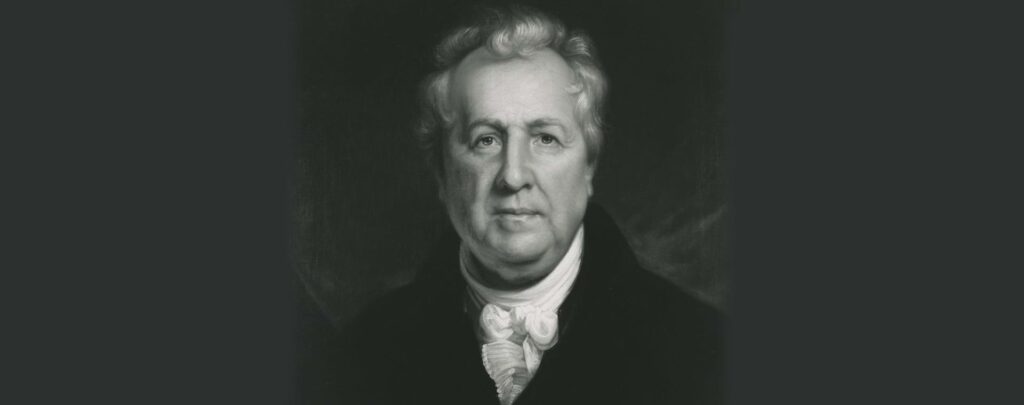Laying the Scientific Foundation in New York City
Described by his contemporaries as a “chaos of knowledge,” a “living encyclopedia,” and a “stalking library,” first Academy President Samuel L. Mitchill dabbled in a variety of disciplines, building a unique level of scientific proficiency that was very rare at the time.
Published May 1, 2017
By Douglas Braaten, PhD
Chief Scientific Officer and Editor-in-Chief of Annals of the New York Academy of Sciences

Samuel Latham Mitchill was a rare polymath for his time.
Born in North Hempstead, New York, in 1764, he had remarkably varied interests, which ranged from medicine to geology, botany and mineralogy. A farmer’s son, Mitchill exhibited great interest in the natural sciences early in life. After studying the foundations of medicine with his uncle, doctor Samuel Latham, Mitchill went to the University of Edinburgh to earn his medical degree in 1786 and then returned to New York, where he received a license to practice medicine. The route he chose, however, was far from a typical doctor’s path.
Because of his boundless thirst for knowledge, Mitchill couldn’t fully settle on pursuing any one scientific field. His contemporaries described him as a “chaos of knowledge,” a “living encyclopedia,” and a “stalking library.”
He kept dabbling in a variety of disciplines, building a unique level of scientific proficiency, which was very rare at the time. It wasn’t surprising that his wide array of interests and expertise earned him an appointment as a Chair of Natural History at Columbia University, at the age of 28. At Columbia, Mitchill’s scientific career truly flourished. He taught chemistry and botany, and expanded his work into other areas of science.
Promoting Geology, Agriculture, Chemistry
Mitchill was a prolific publisher and produced a variety of works, once again on a wide variety of topics. He prompted the geological survey of the New York State. He contributed to the development of agriculture by surveying the mineralogy of the Hudson River Valley. His chemistry studies led to improved detergents and disinfectants, and even better gunpowder. For 23 years, Mitchill served as a chief editor of the Medical Repository, one of the top scientific publications of the time.
It would only make sense then, that an erudite man like Mitchill would lay the foundation for the New York Academy of Sciences. In 1817, he organized the first meeting of the Lyceum of Natural History (the Academy’s early name), which took place at the College of Physicians and Surgeons in Lower Manhattan. Later elected as the Lyceum’s first President, Mitchill remained in that post until 1823.
Under his supervision, the Lyceum hosted lectures, preserved samples of natural artifacts, and established a library. Seven years after the Lyceum’s commencement, it began publishing The Annals of the Lyceum of Natural History of New York — one of the first American journals of natural history and science. The Annals published articles on myriad topics, from research on swallows by its Member John James Audubon, to descriptions of newly found species.
As the years progressed, the organization started by Mitchill continued to grow, adding more activities to its list. New York State commissioned the Lyceum to do a survey of its mineralogy, botany, and zoology. The Lyceum also became instrumental in launching organizations dedicated to scientific research and literacy, including New York University in 1831, and the Museum of Natural History in 1868.
Science and Politics
Like many other great scholars who sought to educate societies about science, Mitchill worked to emphasize the importance of scientific progress in the American legislature and politics. In 1801, he resigned his Columbia appointment and took a seat in the U.S. House of Representatives. Later, he served a term in the Senate, and then once again in the House. He was an advocate of quarantine laws, and an avid proponent of the Library of Congress.
Mitchill was also instrumental in the creation of educational institutions including Rutgers Medical College, where he served as Vice President during the college’s first four years. Despite being preoccupied with his political efforts and other endeavors, Mitchill never stopped working on his scientific pursuits, and remained very productive in his research publications throughout his life.
As historian Alan Aberbach once wrote, “To Mitchill it was axiomatic that with diligence and empirical practices, developing systematically and organically, one could come to grips with and resolve the historical plagues of mankind’s ills.”
